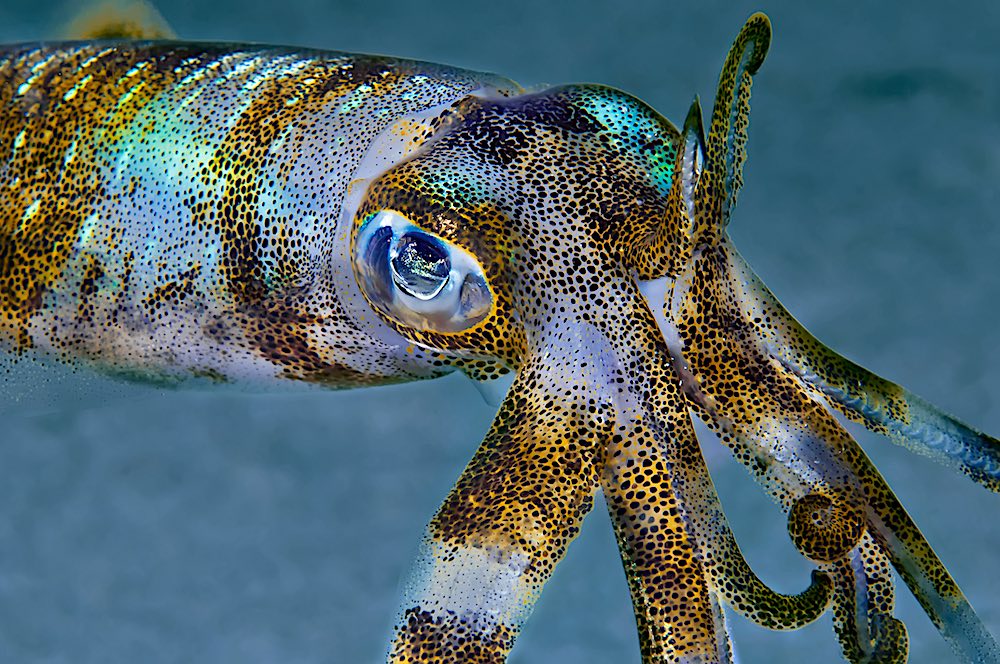Cephalopods of Koh Tao
Learn about Cephalopods on Koh Tao
There are four different types of Cephalopods and they are all invertebrates and on Koh Tao we are lucky enough to see three of these sub classes.
Highly intelligent Cephalopods include the ten armed squids & cuttlefish, the eight armed Octopus and the shell chambered Nautilus (Argonauta hians).
There are over 30 recorded species of Cephalopods found in the Gulf of Thailand including the Paper Nautilus however, many of them are rarely seen by scuba divers around Koh Tao.

Evolution of Cephalopods
Cephalopods have arms or tentacles and the ability to use propulsion when they need to move quickly and of course blue blood.
They are all invertebrates and use gills to breathe, they tend to grow fast and only have short lifespans from just 1 – 3 years.
Cephalopods also have two eyes, a mantle, a funnel and lots of tentacles.
During early evolution Cephalopods enjoyed the solid protection of shells but as they evolved many lost the shell and started to rely on various adaptations.
Adaptations include a heightened intelligence, strong flexible tentacles, an ability to adapt to their surroundings and a real talent for hiding in small cracks or right in front of you using camouflage.
Octopus Koh Tao
Octopus are quite a rare sight around Koh Tao and you will need to swim slowly and have a sharp eye to be lucky enough to see one when scuba diving on Koh Tao.
We have seen three species here; Blue Ringed (Hapalochlaena maculosa), Mimic (Thaumoctopus mimicus) and Marbled (Octopus dollfusi) Octopus.
Octopus have a complex nervous system, excellent eye sight and are the most intelligent of all invertebrates.
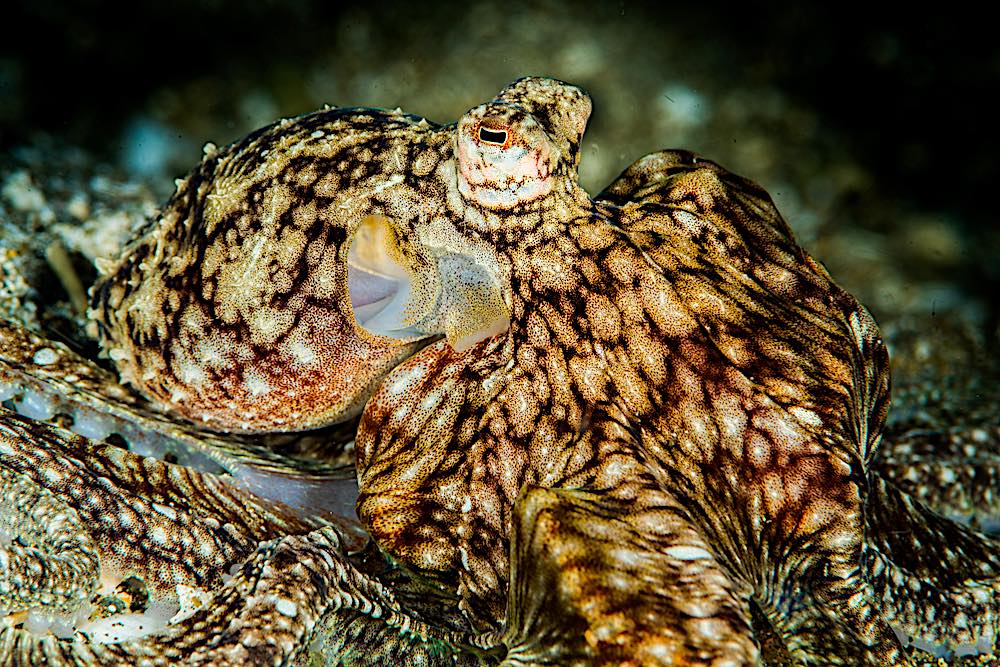
Where to find Octopus on Koh Tao
We see Octopus at a variety of dive sites including White Rock and Twins and the shoreline of Koh Nang Yuan north of Japanese gardens and west from Red Rock.
Octopus on Koh Tao are seen at Tanote bay, Tao Tong and diving at night is often when we catch sight of an Octopus.
How to Identify an Octopus
This can be difficult when you consider their ability to change colour and camouflage themselves extremely effectively.
There are over 300 species of Octopus and like all Cephalopods they are bilaterally symmetric, which means they have two eyes, a beak and their mouth is the centre point of their 8 legs.
They have a funnel that is used for breathing and moving and they move by expelling jets of water through their funnel and their 8 limbs trail behind them.
They tend to use their back two arms to walk on the reef or sea floor which is their preferred method of locomotion.
Over 300 Species of Octopus
Rows of suckers in the underside of their arms allow the Octopus to move forward along the sea bed and they use their other six arms to forage for food.
Their large hollow mantle is joined to the back of the head, and is a highly muscled structure containing all the vital organs.
Their bodies are soft, which allows Octopus to rapidly change shape and squeeze through small holes or gaps in the rocks.
How an Octopus Eats
The mouth that is located under the arms, has a sharp hard beak that the Octopus uses to break the shells of crustaceans and molluscs.
Next to the beak is a barbed tongue called the radula, which the Octopus uses to scrape an animal out of the shell once opened.
If that is not successful, the Octopus will use its salivary papilla, a tooth covered organ it uses to drill into shells and the secretion of the Papilla erodes the shell so the Octopus can eat whatever is inside.
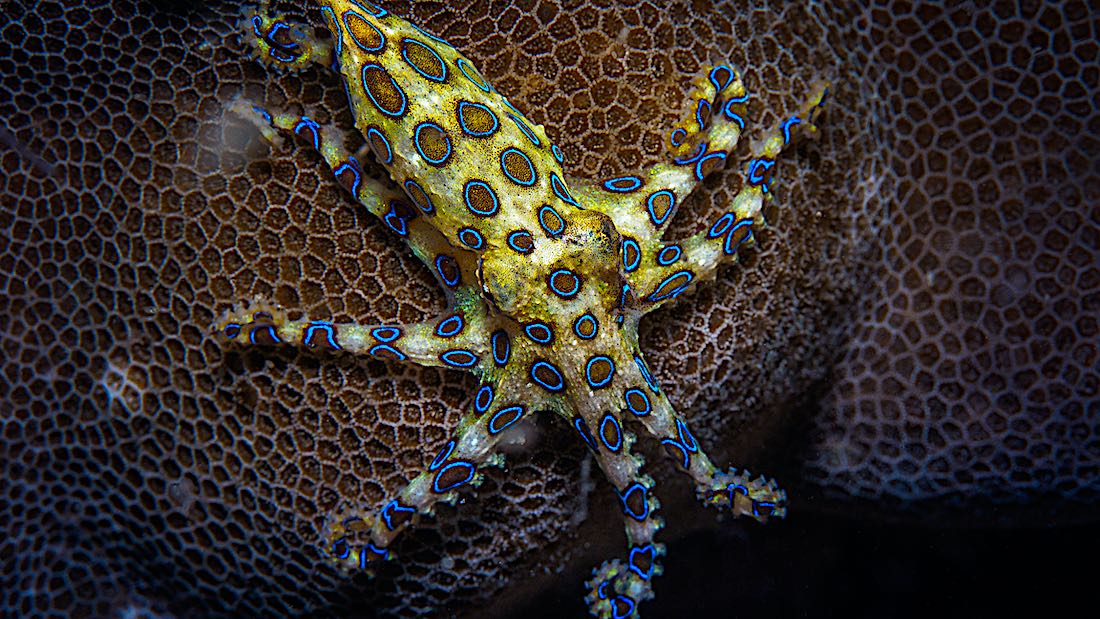
Octopus Characteristic Behaviour
- The Octopus is a solitary animal and spends most of its life in a den leaving at night to hunt.
- Octopus have a variety of ways to defend themselves against predators including expelling ink, using camouflage and threat displays and they can move quickly through water if they have to escape.
- An Octopus is able to change colour in less than a second.
- A mimic Octopus has been observed displaying dynamic mimicry behavior and impersonating flatfish, lionfish and sea snakes amongst other marine animals.
- A common method of hunting whilst swimming is for the Octopus to envelop its prey in the skin between its tentacles before devouring it with its beak.
- Octopus are unbelievably strong and incredibly flexible with their arms almost entirely made up of muscle and they are strong enough to break through perspex glass.
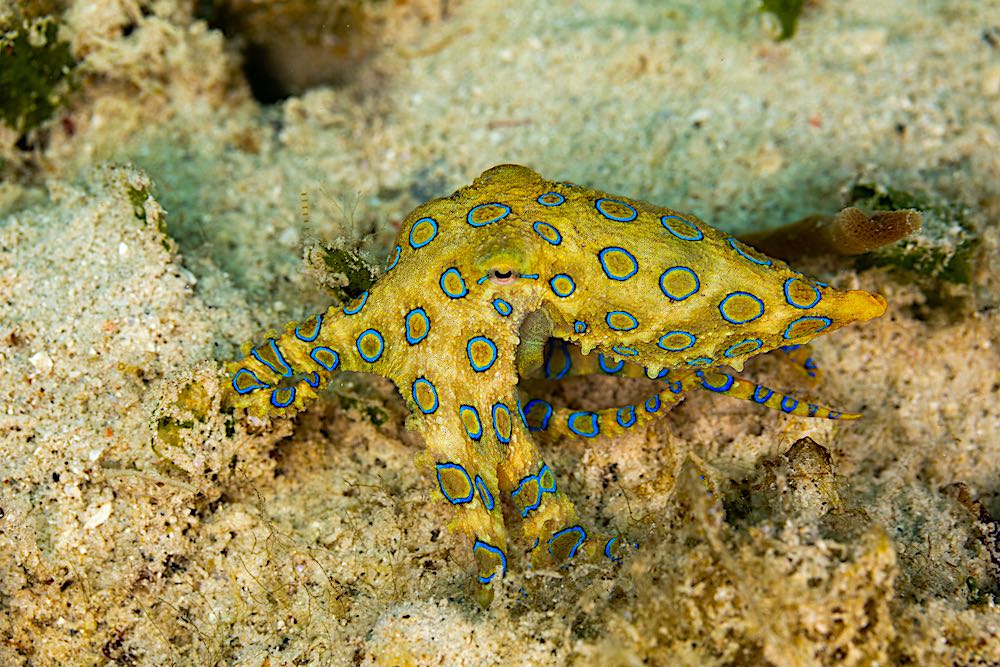
Interesting Facts about Octopus
An Octopus has 9 brains with a large central brain and a large ganglion at the base of each arm that controls its movement.
Their central brain is as big, proportionally as some birds and mammals and the Octopus displays high levels of organisation and has shown evidence of short term memory.
An Octopus is excellent at spotting prey due to its excellent eye sight and their eyes, like ours have an iris, pupil, lens and a retina.
Octopus blood is a poor carrier of oxygen so to cope with low oxygen levels the Octopus has to maintain a constant high blood pressure and it has 3 hearts.
Largest Octopus is the Giant Pacific Octopus
Two of the hearts pump oxygen rich blood through the gills, the third circulates oxygen through the rest of the body.
Most Octopus species grow quickly, mature early, breed and then die and the male dies a few months after he fertilises the female.
The female deposits the eggs in her den and cares for them until they hatch and then she dies.
The largest Octopus is the Giant Pacific Octopus that grows too over 15kg and has an arm span of over 4 metres.
The smallest is Octopus wolfi, otherwise known as the star-sucker Pygmy Octopus, which is 2.5cm long and weighs less than 1 gram.
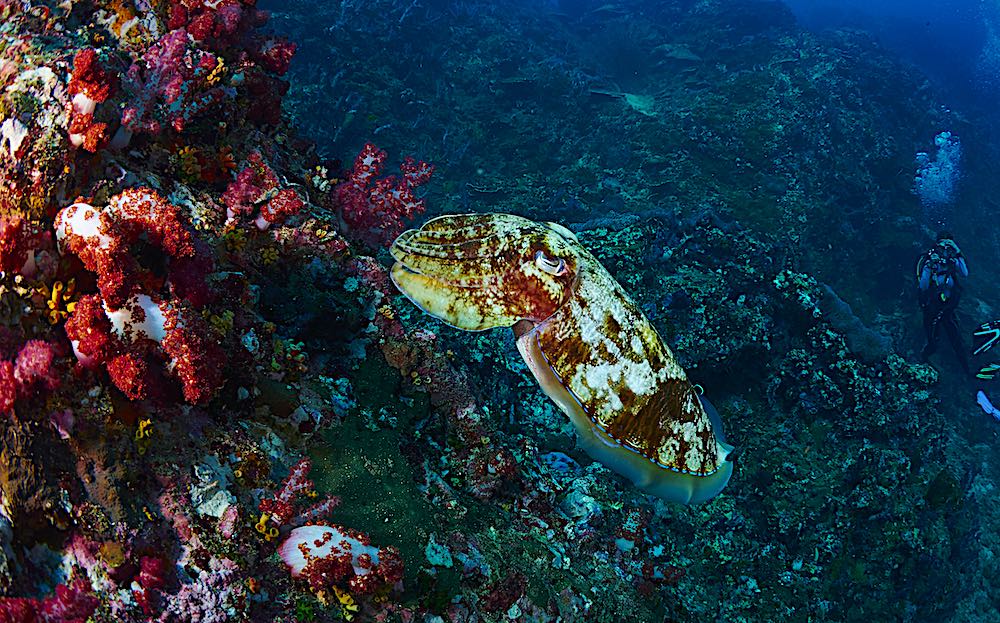
Cuttefish Koh Tao
We often see Cuttlefish diving Koh Tao both during the day and also at night.
There are 9 recorded species of Cuttlefish in the gulf of Thailand and the most common we see around the waters of Koh Tao are the the Broadclub cuttlefish (Sepia latimanus) and the Pharaoh cuttlefish (Sepia pharaonis).
Where to find Cuttlefish on Koh Tao
As scuba divers we see cuttlefish during the day and night at a variety of dive sites around the coastline of Koh Tao.
You can find them at Pottery Pinnacle, Junkyard Reef, Aow Leuk and around Koh Nang Yuan at Twins, Red Rock and Japanese Gardens.
We also see cuttlefish at dive sites further out such as South West Pinnacle and Chumphon Pinnacle.
How to Identify a Cuttlefish
Cuttlefish are typical Cephalopods with sophisticated large eyes and a W shaped pupil.
They have 8 arms and 2 tentacles with suckers attached, which they use to catch their prey.
They generally range in size from 15 to 25 cm in mantle length, although the largest species can grow to 50cm.
Broadclub Cuttlefish
Broadclub cuttlefish are a light brownish yellow colour with white spots and patches, although during mating males are sometimes a dark brown.
Their arms have white or sometimes brown bands running down from their head to the end of the arm as does the top of the mantle and their fins are pale and white.
Pharaoh cuttlefish are more often one solid color and change from a white to dark brown depending on the background.
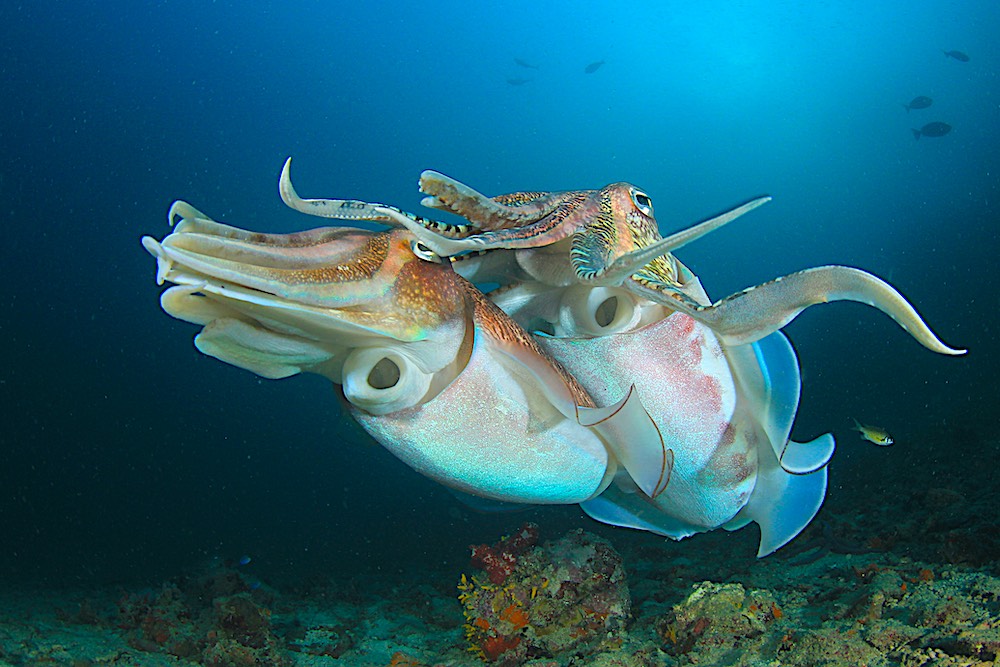
Cuttlefish Characteristic Behaviour
- Cuttlefish eat a wide variety of crustaceans including fish, Octopus, worms, and other cuttlefish.
- Sharks, seals, seabirds, dolphin and fish all prey on Cuttlefish.
- Cuttle fish have the largest brain-to-body size ratio of any invertebrate and together with the Octopus, are said to be the most intelligent of invertebrates.
- The broadclub Cuttlefish is found around coastal areas, close to or on coral reefs or rock and reef formations in relatively shallow water to depths up to 30metres.
- The broadclub cuttlefish is a diurnal species, which means we see it during the day when it is active and not during the night.
- The Pharaoh cuttlefish is more often seen at night.
- Cuttlefish are able to rapidly alter their skin colour, within 1 second in order to communicate to other cuttlefish, camouflage themselves or as a means to warn potential predators off.
- Cephalopods communicate visually with a varied range of signals.
- The four categories of signals are skin coloration and changing colour, changing the texture of their skin (from smooth to rough), posture and locomotion and in several species of cuttlefish, scientists have recorded more than 40 distinct signals.
Interesting Facts about Cuttlefish
All cuttlefish have a cuttlebone that is an internal shell, which is a chambered gas filled shell and the cuttlefish uses it to control its buoyancy.
You will often see cuttlebones washed up on the beaches around Koh Tao and these will either be from cuttlefish that have died or been eaten and the predator has spat out the cuttlebone.
Male cuttlefish compete with other male cuttlefish for dominance during the mating season, threatening each other until one backs down.
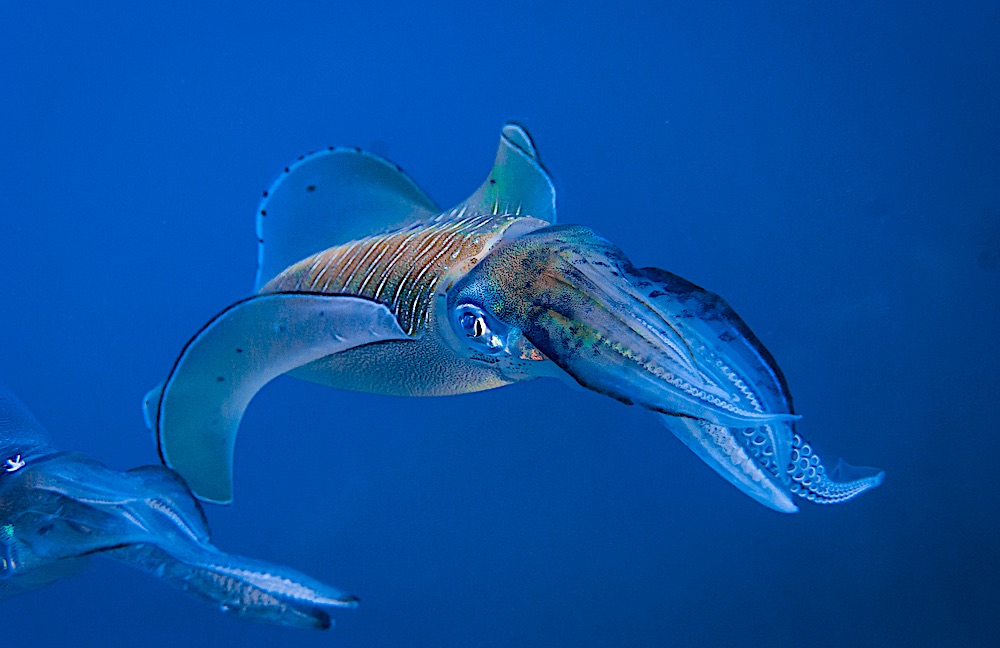
Cuttlebone Controls Buoyancy
The winner then mates with the female in a highly ritualized visual display much like their hunting behavior.
Eventually he will hold her with his tentacles and use a special tentacle to insert sperm sacs into an opening close to the face of the female and then guard the female until she lays eggs several hours later.
After laying the eggs she will then secrete ink that produces an egg case that represents a natural barrier between the developing embryo and environment.
Squid on Koh Tao
The most common squid we see when scuba diving around Koh Tao is the Big Fin Reef squid (Sepioteuthis lessoniana).
Scientists believe that there are likely to be several similar and closely related species to the Big Fin squid.
Where to find Squid on Koh Tao
You can see Squid at many of the dive sites around Koh Tao and divers will often see Big Fin squid around the buoylines of our favourite dive sites.
You can also see Big Fin squid during night dives around Koh Tao, as they are often attracted to the light given off by the torch.
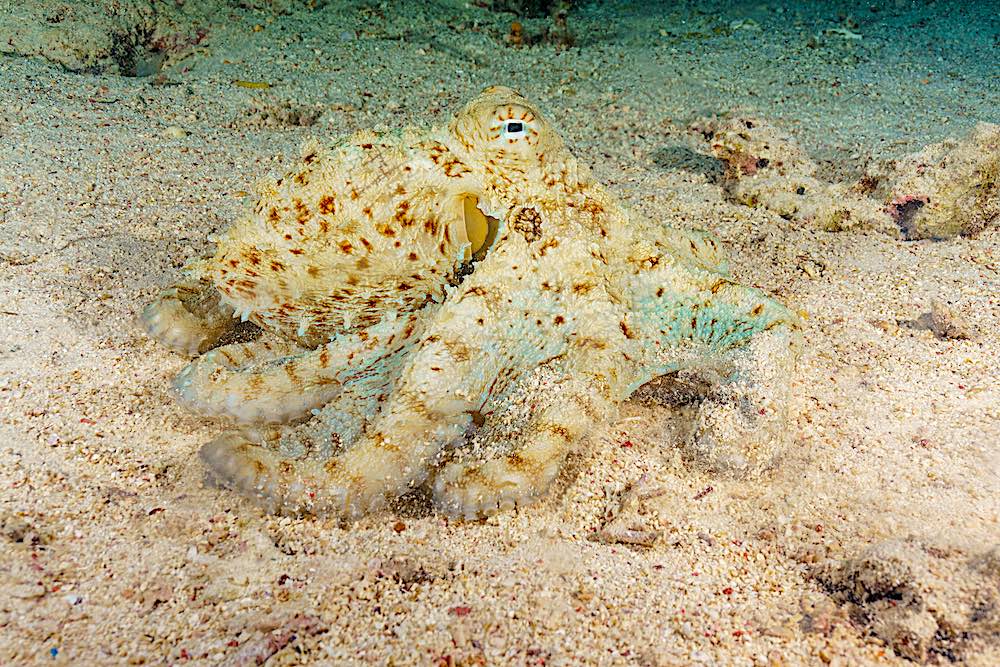
How to identify Squid
Like all Squid from the genus Sepioteuthis bigfin reef squid are easy to distinguish with their large, thick muscular oval fin that is attached to the mantle and it is this fin that the Big Fin squid gets its name from.
BigFin Reef Squid look very similar to cuttlefish, a fact reflected in its scientific name.
The oval fin extends to between 83 to 97% of the entire length of the mantle and is 70% of the total length of the mantle, wide.
The size of Big Fin squid ranges from below 4cm to over 33cms and they are classed as a small to medium-sized squid.
All squid have large eyes with very good eyesight and the eyes of Big Fin reef squid are a greenish color at the base and are covered by a transparent secondary cornea.
Characteristic Behaviour of Squid
The diet of Big fin reef squid consists mainly of crustaceans and small fish and the main predators of Big Reef squid include Tuna, Marlin, Swordfish and a number of Benthic fish.
You can find Big fin reef squid near to the shore and around coral reefs and rocks.
Big Fin Reef Squid Paralarvae already look like mini adults and incredibly, they already have the ability to change colour as soon as they hatch.
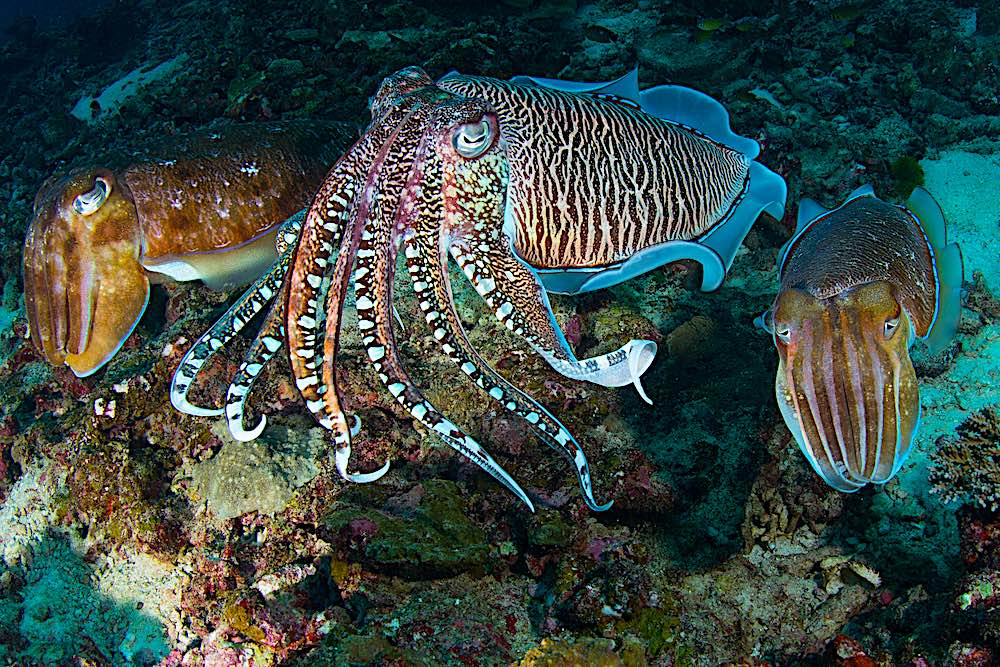
Interesting Facts about Bigfin Reef Squid
Big Fin Reef Squid have the fastest growth rate of any large marine invertebrate and can reach 600 grams in only 4 month.
Like all Cephalopods, Bigfin Reef Squid only have short lifespans and the maximum recorded lifespan of a Bigfin Reef squid is 315 days.
Bigfin Reef Squid have eight arms that are unequal in length and all of them possess two rows of suckers that are less than 2mm in diameter.
The left arm of the fourth pair of arms is modified into a sexual organ that is called the hectocotylus.
Huge quantities of Big fin Reef Squid are fished around the waters of Asia due to the popularity of this species in Asia as food.
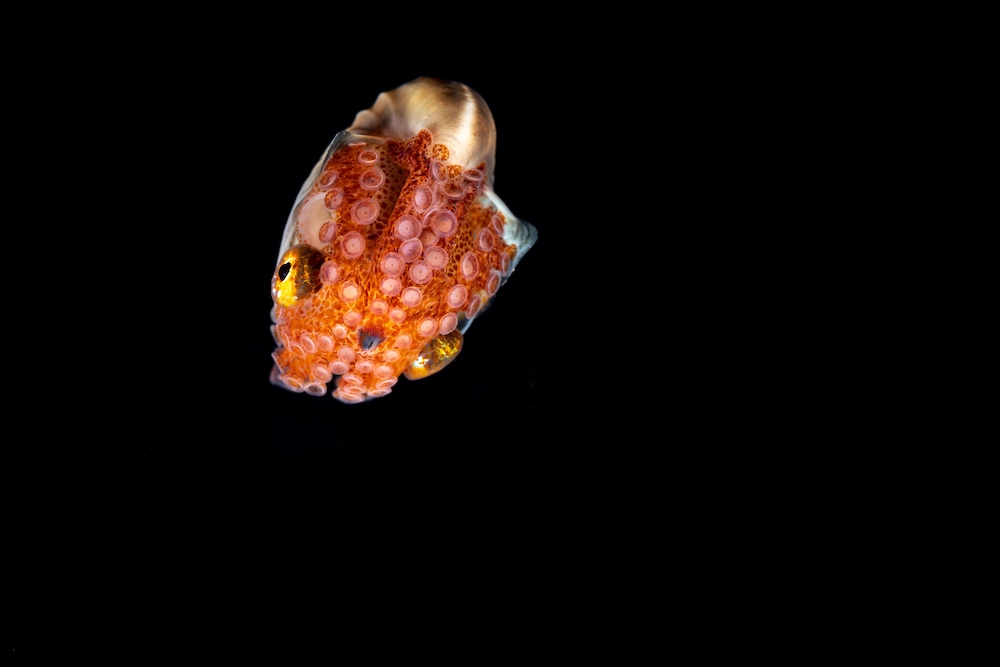
Argonauts – Paper Nautilus
The name argonaut derives from Greek mythology meaning sailor of the argo and this group of pelagic Octopus are also commonly called Paper nautiluses.
The name nautilus comes from the Greek work that translates in english to Nautilus, literally meaning sailor and the Paper refers to the paper thin shell or eggcase the female has.
It was originally thought Argonauts used two of their arms as sails but this is not true and like other Cephalopods, they swim by quickly expelling water from their mantle through their funnel.
The argonauts are the only living member of the family Argonautidae and all other species are extinct and there are fewer than 10 living species.
Where to find Argonauts on Koh Tao
You will be very lucky to see Argonauts whilst scuba diving on Koh Tao as they spend their lives drifting near the surface and are predominantly an open ocean species.
They are found in the Gulf of Thailand and often caught as bycatch by the fisherman.
One such species of the Argonaut found in these waters is the Argonauta hians sometimes called the brown paper nautilus or the muddy argonaut.
How to identify Paper Nautilus
Like most Octopus, Argonauts have eight arms and a rounded body.
Their eight arms are unequal in length, each with two rows of suckers and the number of suckers varies from species to species.
The male does not have the dorsal tentacles that the females uses to create their eggcase and it uses a modified arm, called the hectocotylus that transfers sperm and fertilises the female.
The hectocotylus becomes detached and is often retained in the eggcase along with the eggs and the female also takes shelter in the egg case.
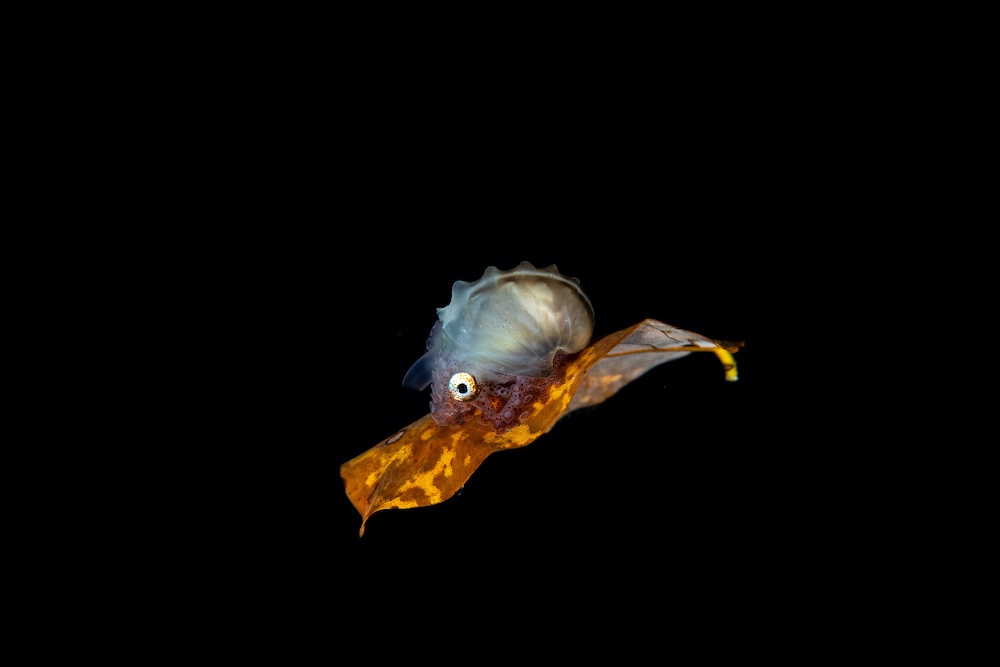
Characteristic behaviour of Argonaut
These egg cases are sometimes found floating on the surface and they contain a bubble of air that is captured on the surface and used for buoyancy.
The female may be seen with her head and tentacles protruding out from her egg case but she will retreat inside if threatened.
Whereas other species of Cephalopods eat crustaceans, Cephalopods and bony fish, Argonauts feed on pelagic sea snails, sea slugs (Pteropods & heteropods), jellyfish and small fish.
Argonauts mostly feed during the day and use their tentacles to grab and drag their prey to their mouth and then bite the prey, which injects venom from the salivary gland.
Natural Predators of the Argonauts include Tuna, Sharks, Squid, marine mammals, penguins and marine birds.
Interesting Facts about Argonauts
Argonauts have an extreme sexual dimorphism in size and the male is much smaller than the female.
Male Argonauts grow to 1cm and rarely surpass 2cm in length and they also do not grow shells. However, females grow up to 10cms and can make shells up to 30cms.
The female secretes a shell with an enlarged web of dorsal arms, functioning as an elaborate egg case and the egg case provides protection to the female and a place to attach her eggs too.
